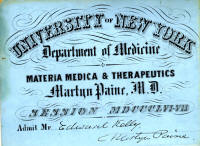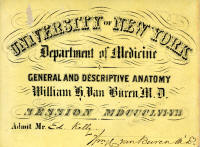Navy Board Exam for applicant Dr. Edward Kelly 1862
(Biography and exam transcription courtesy of the Norman L. Herman collection)
I was born the city of St. John, province of New Brunswick, on the 26th day of August 1836, and I am now 25 years, 7 months, and 12 days old. I came to the United States at the ages 17 and a citizen of this country.
My classical knowledge is not very extensive, having in the bustle of life forgotten a great deal; I read the books of Caesar, Sallust, Virgil, and Horace, and through a part of Xenophon in Greek, I studied a little of French, but have almost forgotten it not having to use it.
I finished my preliminary education in the Seminary of Quebec Canada, I began the study of medicine in 1853, by entering a drug store as clerk in the city of New York, I remained in the store until the fall of 1855, when I entered the Medical School of New York, and from this institution I graduated in March 1857.
During the period of my study in the college, I had for my preceptor Dr. John Burke of New York, who was also a graduate of the University of the class of 1849; I attended the hospitals of the city, where I had it fine opportunity of witnessing operations performed by eminent Surgeons of New York, as Drs. Wood, Van Buren, Carnochan etc.
I practice medicine in the city of New York, in company with my preceptor Dr. Burke for about two years, I afterwards practiced in Brooklyn, until [sic] the excitement attending this war induced me, to accept a position in a battery, to which I am at present attached.
April 7th 1862
Naval Asylum, Philadelphia Edward Kelly
297 Degraw St
Brooklyn, N. York
Questions to be answered in writing, by, Dr. Edward Kelly
1. What is Ophthalmia, and what are its varieties?
2. What are the symptoms of retention + suppression of urine, and the causes of each?
3. Describe briefly, the umbilical cord, the mode of cutting and dressing it.
4. [in a different hand] What arteries are situated in the hand?
5. What are the characteristic properties and principal chemical combinations of lead?
6. What are the medical properties and uses of tartarised antimony?
7. Describe the symptoms and causes of Hectic Fever.
8. In aortic regurgitation of the blood which sound of the heart does the abnormal murmur accompany, and where is it most distinctly heard?
9. How was Oxalic Acid easily distinguishable from Sulphate of Magnesia and what is them treatment of its effects?
Answers
1. Ophthalmia is inflammation of the Conjunctiva, it is divided into simple and purulent or gonorrheal, the former may be caused, by the action of cold, injuries etc. But the latter is generally the result of direct contact with purulent matter, as the matter of gonorrhae [sic, correction marks in pencil].
2. Retention of urine may be caused by spasmodic stricture of the urethra, by calcului [sic, correction marks in pencil] in bladder, blocking up its mouth, by paralysis of the bladder, which may be caused by retaining the urine for a long time, and by calculi in urethrae [sic]; suppression of urine is caused by Nephritis, calculi lodge in the ureters, and in some cases by the operation of the passions.
The symptoms of retention are, 1st the hard tumour felt by pressure with the hand above the pubis, this, if the bladder be much distended will cause a great deal of pain, the patient’s countenance wears a look of distress, and he has a small quick pulse; in suppression the pulse may be full and quick, unless when there are calculi in the ureters, the patient often feels a desire to pass his water, but when you introduce a catheter, no water is to be found.
3. The umbilical cord is composed of two arteries and one vein, it is enveloped by membrane, which is a continuation of the membrane enveloping the liquor amnii. It is divided at about 3 inches from the umbilicus, care being taken not to injure the fingers, (or if a boy,) the penis with the scissors; I had nearly forgotten that it must be tied, before division; it is to be enveloped in a soft rag that, as evenly as possible, and laid upon the left side of the child, as the pressure on the right side might injure the liver.
4. We have in the palm of the hand the arteries composing the palmar arch, branches of (or rather) terminal branches of the Radial and Ulnar arteries, the interosseous arteries, and the digital arteries.
5. Lead is a soft, malleable metal, of a slightly sweetish and astringent taste used in medicine principally as an astringent in conjunction with opium, and in solution, as a cooling lotion; its chief chemical combination is carbon forming carbonate of lead.
6. Tartarised antimony is alterative, emetic, and rubefacient, in small doses from 1/8 to 1/4 of grain it will afford marked relief in pleuritic effusions with great dyspnoea; as an emetic it is given in doses of one or two grains, generally combined with ipecacuanha, as a rubefacient a drachm to an ounce of adiss [sic, correction marks in pencil] will produce a crope [sic] of pustules, somewhat resembling variola. It will also produce relaxation of rigid parts, and for this purpose is often used in midwifery when the Os Ueteri is very rigid, and was used in reducing dislocations before the discovery of chloroform.
7. Hectic fever is caused by pus in the blood, which may be produced by abscesses, injuries as in compound fractures, where the wound did not heal by the first intention, phlebitis, and the last or purulent stage of Pneumonia, we see it most commonly in the last stages of Phthisis.
The patient feels feverish towards evening, restless, flushed face, the redness is generally confined to a small part of the cheek, the pulse is small and quick, and at night he sweats profusely, which leaves him very much weakened and prostrated.
8. The diastole, and is the most distinctly heard, by applying the stethoscope between the second and third ribs, at their insertion in the sternum.
9. Oxalic acid may be distinguished from sulphate of magnesia by the size of its crystals, and by its taste, in poisoning from this acid, the treatment is to give magnesia, lime, etc.
April 8th 1862
Edward Kelly
At this point, we don't know if or why he passed or failed. He does not show up in the Navy surgeon's list.
Return to the University of New York Medical College lecture ticket page for Kelly

